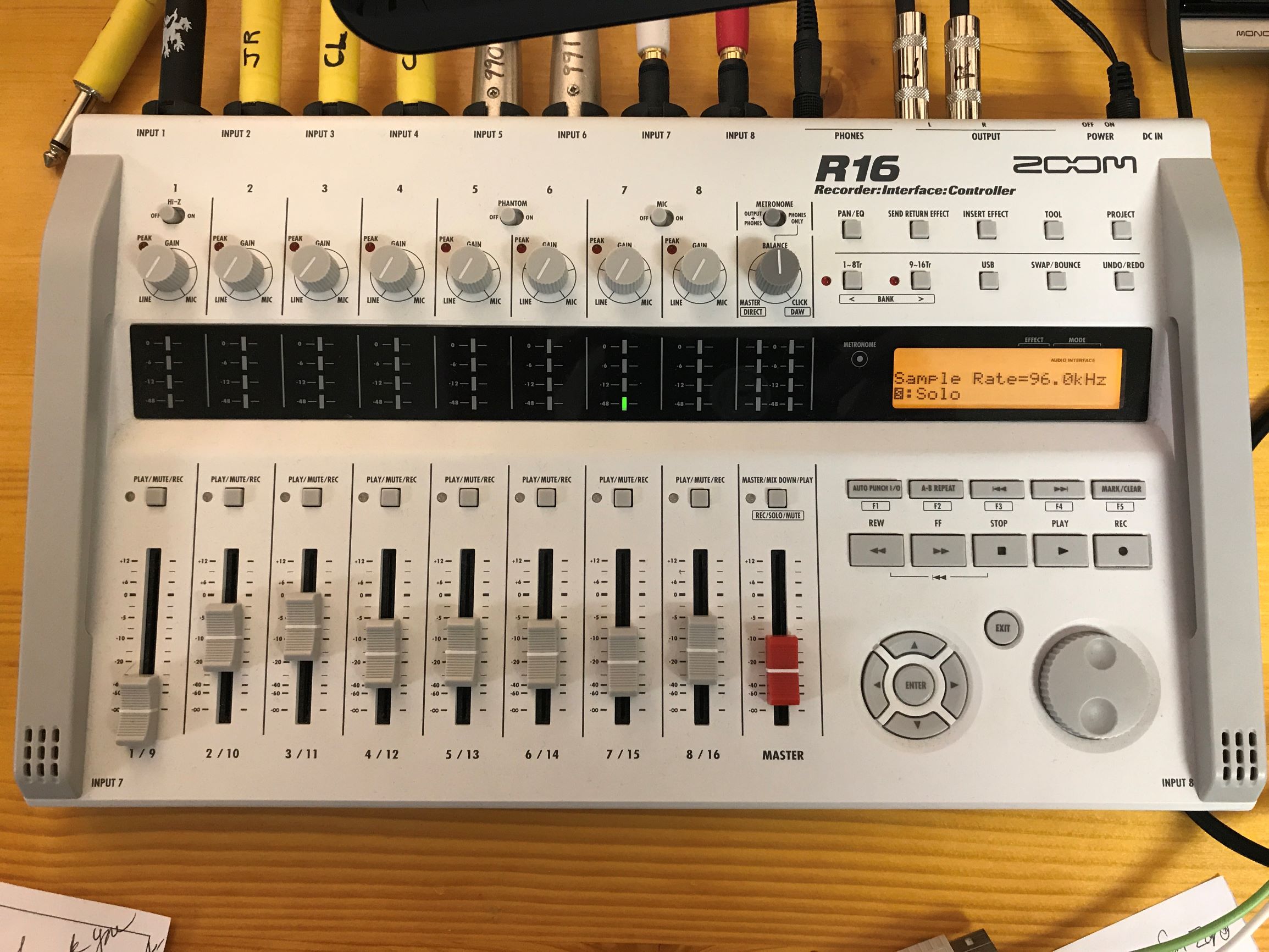Table of Contents
- Do This First!
- Purpose of this Post
- Disclaimer
- Please Note
- Check If the Zoom R16 Shows Up in Device Manager
- Are You Experiencing Latency?
- Download and Update ZOOM R16 Firmware if not Current: (OPTIONAL, BUT RECOMMENDED)
- Troubleshooting Steps
- Check Audio Interface Settings
- Check the Control Surface Setting
- To Resolve Both Issues, Reset the Zoom R16’s USB Mode
- Check Audio Interface Settings Again
- Check Control Surface Setting Again
- Reboot Computer
Do This First!
Before you dive into troubleshooting your Zoom R16 in Reaper on Windows, have you set it up properly yet? Here is another post where I go through the compete setup: Zoom R16 – Audio Interface and Control Surface Setup in Reaper on Windows (Will open in a new tab.)
Purpose of this Post
This post is being written to share some Troubleshooting tips I’ve learned while using my Zoom R16 in Reaper on Windows.
Disclaimer
I do not work for Zoom, makers of the R16, nor Cockos, makers of Reaper, however, I use both products heavily in music production. I simply want to share some helpful tips I’ve learned with you, so you may get the most functionality out of your own Zoom R16, specifically while using Reaper.
Please Note
These instructions may help you with other Windows-based DAWs like Cubase, Pro Tools, FL Studio, etc., although my main personal experience is with Reaper. You would just have to figure out where the same type of settings are in your DAW and OS.
Check If the Zoom R16 Shows Up in Device Manager
- Log into your computer and open Device Manager:
- Click Start / Type PC / Right-Click This PC / Click Manage.
- Click Device Manager / Expand Sound, video and game controllers. (See screenshot below)
- Attach the Zoom R16 to your computer using an available USB port. (If attaching directly to a USB port, it will power on.
- If attaching to a USB hub with switches to power on each USB port like I do, press the button the Zoom’s USB cable is plugged into to power it on.
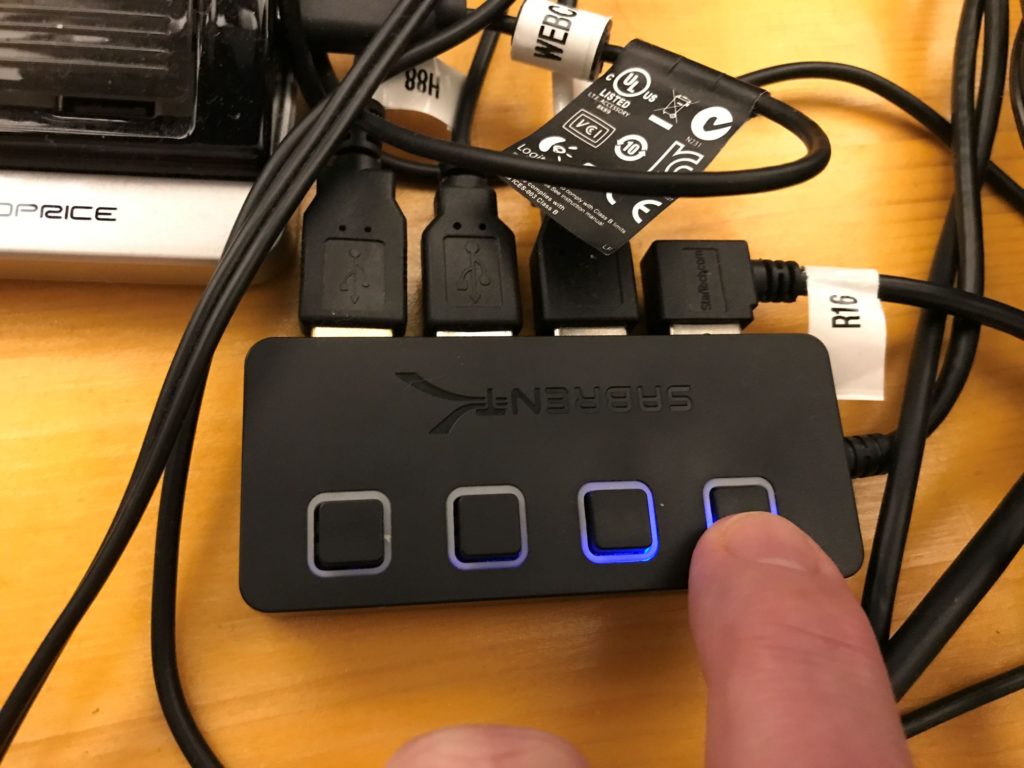
- Go through the Boot the Zoom R16 into Audio Interface Mode sequence. Check this other post for how to do so here –> Zoom R16 – Audio Interface and Control Surface Setup in Reaper on Windows. (Will open in a new tab.)
- The ZOOM R16_R24 Audio Interface should appear (See below).
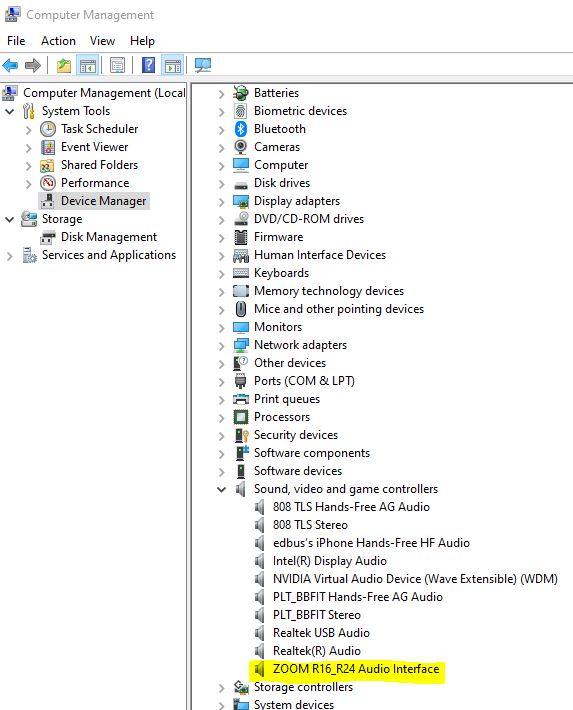
- If it shows up, that means the driver install was successful, and in addition, that the Zoom R16 is attached and powered on. (Typically, in Windows 10, a peripheral device like the Zoom R16 will not show up here until it is physically attached and powered on. You can prove this by powering off the Zoom R16 while watching Device Manager, and it will disappear. Power it back on and it will reappear.)
Are You Experiencing Latency?
Most of the troubleshooting I do in Reaper using my Zoom R16 on Windows is related to latency. These issues crop up intermittently.
What is Latency?
If you’ve never experienced latency, good for you! For example, you’re recording some MIDI drums or keys, and there is a delay between when you hit the drum or synth key and when you hear the virtual instrument play the note. That’s Latency! Latency is absolutely maddening when it happens. Latency also takes the form of pops, clicks, stuttering playback (in Reaper you can see the playback cursor line stop and start), among other undesirable things.
Picture this scene: You’re in the flow state, where that great tune has formulated in your mind, and you’re bursting with creative energy to lay down an initial version of it in your DAW. You start a new project, and right when you hit the first notes on your synth, there is a delay.
What Causes Latency?
Here Is My Guess
Every recording studio and home recording studio is at least slightly different than the next. There is so much hardware and software involved it’s amazing that it can all function properly at all, in my opinion. I am so thankful that it can!
Lots of Components Working Together
Each component in a studio has limits, such as native latency (in milliseconds) and the combination of a computer, Operating System, DAW program, Audio Interface, MIDI and USB instruments and input devices can cause latency from time to time. ASIO4ALL and other ASIO drivers were created to let users adjust some timing settings, to make the latency go away, so they may play and record audio in real time with no detectable delay.
Latency Makes Instruments Unplayable
Instruments become unplayable due to this delay, because it throws your timing way off, and makes it so you’d have to manually fix all of the notes later. The latency has completely killed the vibe. Your creative brain gets sabotaged by having to troubleshooting a software / hardware issue instead of laying down those tracks before you lose the idea for the song.
Tip
If this ever happens to you, record the song idea on your phone, or write it down so you don’t lose it! It’s very easy with computer issues to start troubleshooting and forget what you originally set out to do.
One Solution: Download and Install ASIO4ALL
The ASIO4ALL driver is popular and works well with Reaper. I have adjusted my ASIO4ALL settings when I’ve experienced weird latency issues now and then, completely out of the blue. Latency is a real bummer if you’re working on a project with a tight deadline. It should be eliminated so you can be as creative as possible without technical roadblocks standing in your way. Continue troubleshooting your Zoom R16 in Reaper on Windows using these steps:
- Go to http://www.asio4all.org/ and download the latest version of ASIO4ALL for your language.
- Make a note of where you downloaded the file.
- Open the folder where you downloaded the file.
- Run the installer. (As of this writing, it is called ASIO4ALL_2_14_English.exe.
- Go with the default settings, unless you need the additional functions.
- Whether or not it tells you to, I recommend rebooting your computer.
- To access the ASIO4ALL settings:
- With Reaper open, either if these will get you there:
- In Reaper, Options / Audio / Device / ASIO Configuration.
- Open the SysTray (up arrow down by the time) / ASIO4ALL V2 – REAPER.
- With Reaper open, either if these will get you there:
Download and Update ZOOM R16 Firmware if not Current: (OPTIONAL, BUT RECOMMENDED)
What is Firmware?
The firmware on any device is software sitting on a chip on the device’s circuit board, which controls the hardware environment in the device. In a computer, this is the BIOS (or CMOS). To keep devices working their best, updating to the latest firmware is in general a good idea.
Some folks only update firmware if they read in the documentation that comes with the update that it fixes a specific issue they’re encountering. That’s OK, and could be filed under the “if it ain’t broken, don’t fix it” logic category.
It’s when devices contain sensitive data, like computers, and there are security vulnerabilities being fixed in a firmware (or BIOS) update, in those cases, it’s best to stay as current as possible. The Zoom R16 only contains audio information, so updating the firmware is less urgent.
Only update the firmware if..
If you are comfortable with computers, and can follow technical instructions, then updating the Zoom R16’s firmware should be a simple task for you. If you are afraid of computers, I would ask a friend to help with this if you choose to update it.
Warning: Never unplug or turn off a device during a firmware update, since you could brick it (make it completely unusable).
My Zoom R16 Needs an Update! LOL
While I am writing this, I realize that my Zoom R16 needs an update. The firmware I’ve had installed the last several years has been version 1.21. I have checked now and then and haven’t seen anything newer until today when I see 1.23, which was release in July 2019. I checked the release notes, and the 1.21 version came out in 2011. The new release (1.23) fixes something I think I’ve actually experienced now and then, where I hear a series of weird noises (hard to describe), and then they go away. They are obnoxious at any listening volume.
Note Your Firmware Version
There are 2 ways to locate your Firmware Version:
- During boot up: The Firmware Version displays briefly when the Zoom R16 boots up.
- On Zoom R16 menu: Press the Tool Button, Hit Enter while it displays System on the LCD, Right arrow, Right arrow, Enter while it displays Version. Hit Exit repeatedly until you’re back at the Sample Rate / Solo screen.
- Make a note of the Firmware Version for reference.
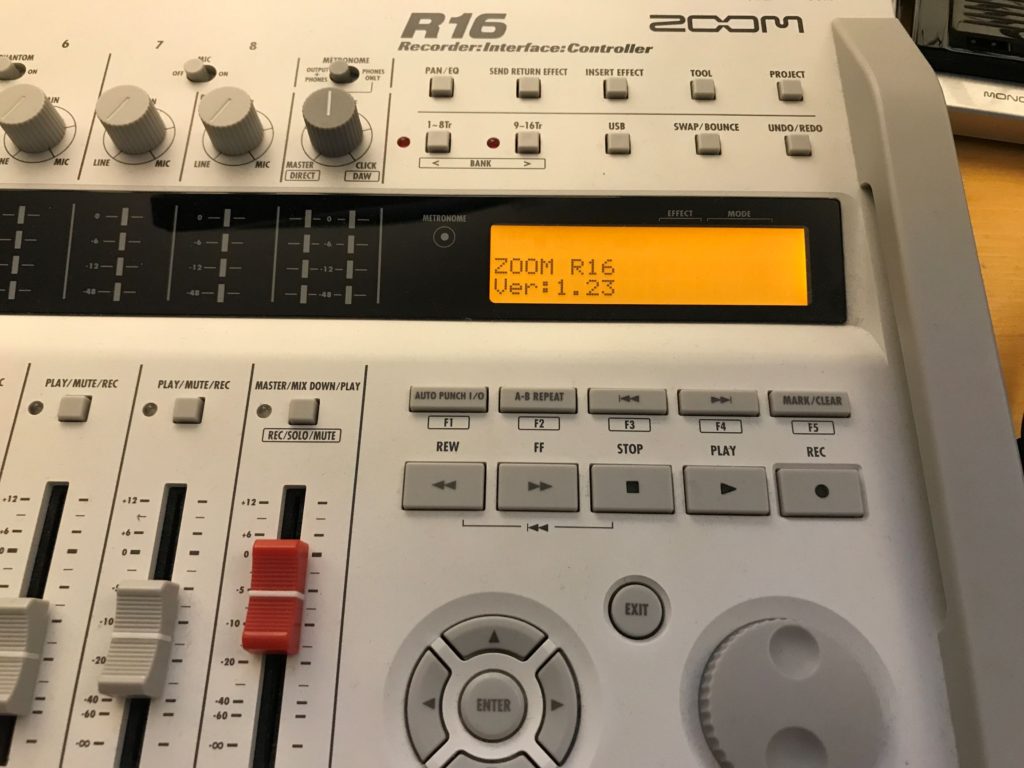
Firmware Update
- Right-Click the link below and choose “Open link in new tab (or Window)” to keep these instructions open. Check what the latest firmware version is , and if it’s newer than your current version, download the firmware to your computer. (Skip to the next section if it’s the same as your current version.) https://zoomcorp.com/en/us/digital-mixer-multi-track-recorders/multi-track-recorders/r16/r16-support/
- Note the location you download it to. (In Windows, the default is usually the Downloads folder.
- Open the folder containing the ZIP file (In this case, R16_v1.23_E.zip).
- Extract (unzip) the file.
- Open the new folder it unzipped the files into.
- You will see the System Software Version History PDF, a Firmware Update Guide PDF, and a .BIN file that is the actual firmware update.
- I recommend opening the System Software Version History PDF and reading what the latest firmware version fixes.
- Open the Firmware Update Guide and follow the instructions. (I would have included the instructions here, but they could change over time, so the vendor’s instructions are best to follow. Plus, they have helpful visuals.)
- I just updated my Zoom R16 from Version 1.21 to 1.23 (see photo above) with no issues following the instructions.
Troubleshooting Steps
The following steps assume you have already gone through the earlier steps to install the Zoom R16 and ASIO drivers, and configured the Zoom R16 in Reaper as an Audio Interface and Control Surface and that it was previously working.
When it’s Working Properly as Audio Interface and Control Surface
On a good day, when the technology gods are smiling upon me, I’ll remember to do the following sequence:
- Boot the Zoom R16 into Audio Interface mode.
- Power on all the instruments and input devices you’ll be using.
- Open Reaper.
- Open a project in Reaper and start working.
- The Zoom R16 is working properly as both an Audio Interface and Control Surface.
When it’s Not Working Properly as Audio Interface and Control Surface
On a bad day, when the technology gods are miffed at you, it looks like this:
- Boot the Zoom R16 into Audio Interface mode.
- Power on all the instruments and input devices you’ll be using.
- Open Reaper.
- Open a project in Reaper and start working.
- The Zoom R16 is neither working properly as an Audio Interface nor as a Control Surface.
Check Audio Interface Settings
- Open Reaper
- Options / Preferences (Ctrl + P)
- Audio / Device
Here’s the Problem
Notice that it has the correct settings for Audio system: ASIO and ASIO Driver: ASIO4ALL v2, but it does not have the correct settings under Enable inputs and Output range.
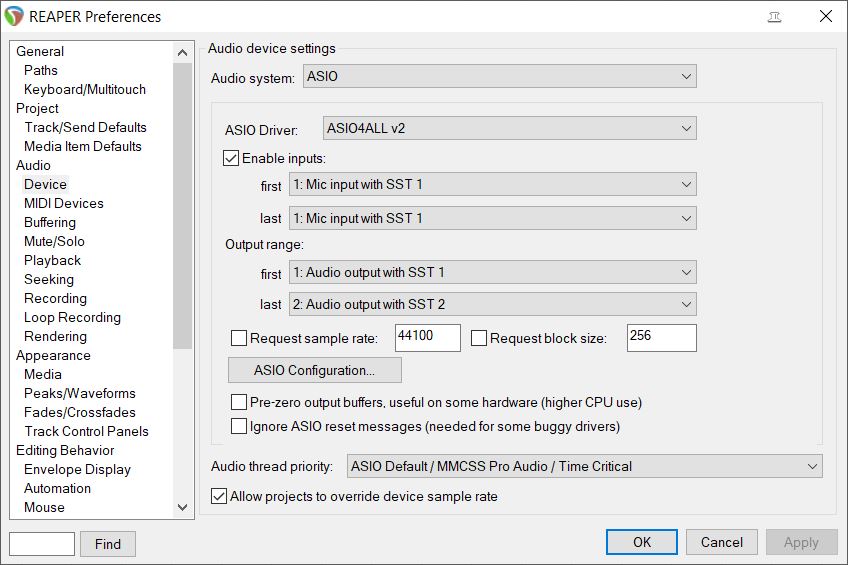
Enable inputs / first: Wrong setting.
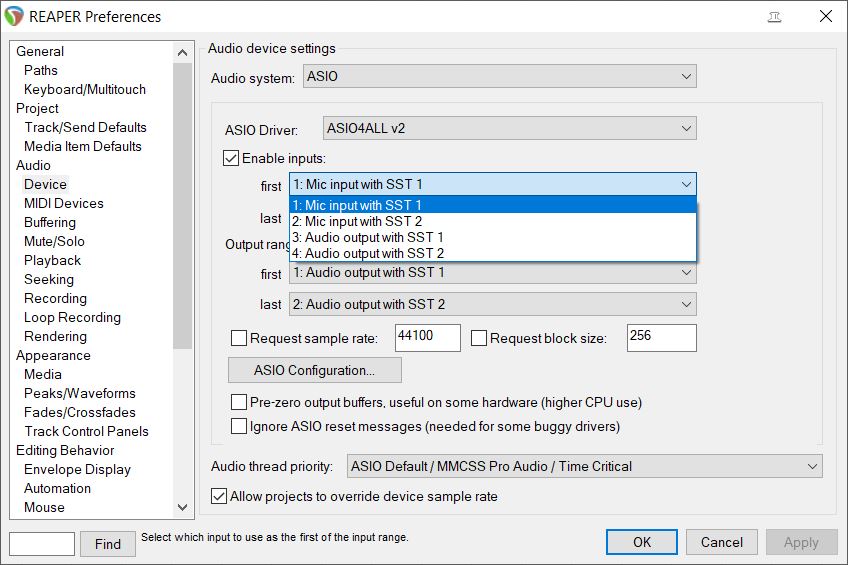
Enable inputs / last: Wrong setting.
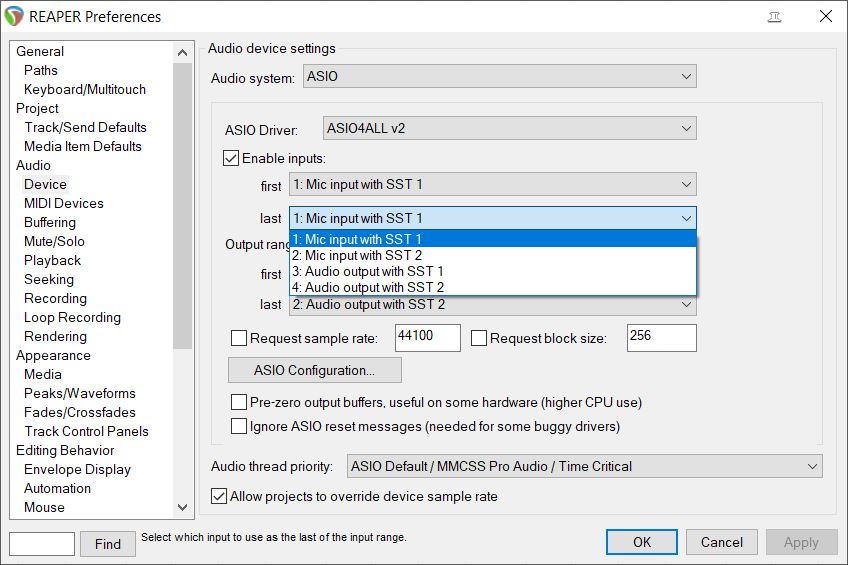
Output range / first: Wrong setting.
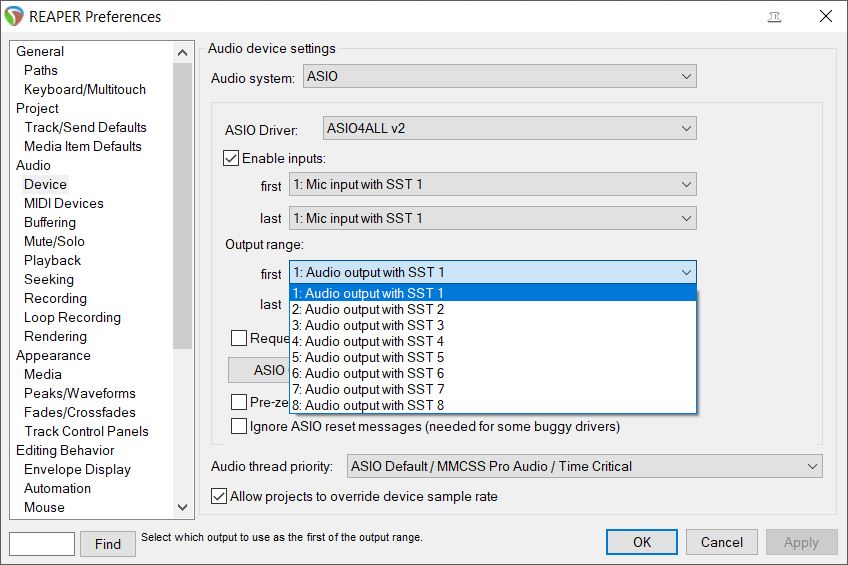
Output range / last: Wrong setting.
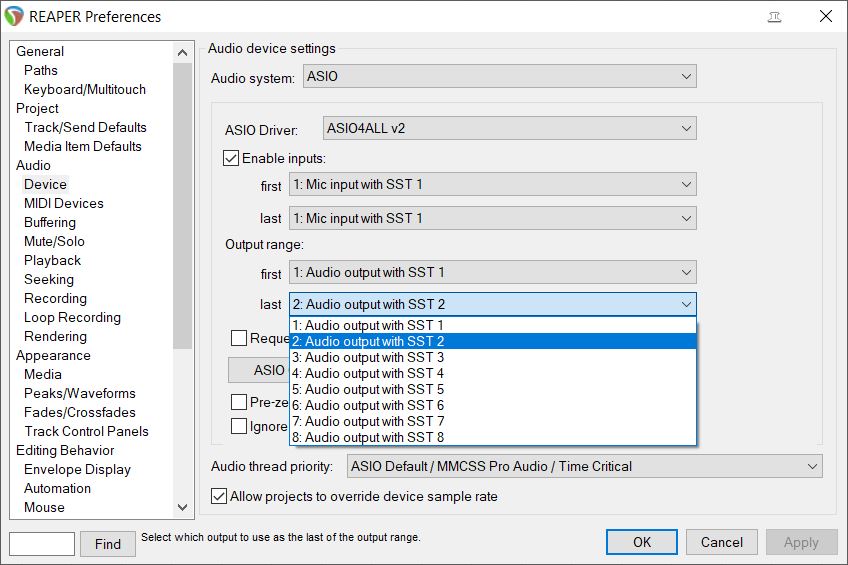
Check the Control Surface Setting
- Open Reaper
- Options / Preferences (Ctrl + P)
- Control/OSC/web.
- Under Control surfaces/OSC/web control:
- Click Mackie Control (dev 10.16)
- Click Edit.
Here’s the Problem
- Here is what it looks like when the Zoom R16 isn’t recognized in Windows, and therefore not working as a Control Surface in Reaper. (Notice that the MIDI Input and Output are blank, instead of showing ZOOM R16_R24 ASIO Audio Interface.)
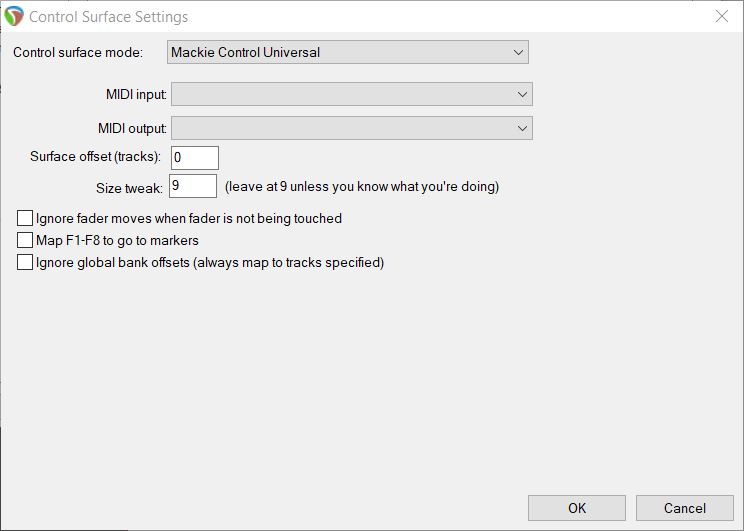
MIDI Input: Notice that the Zoom R16 isn’t on the list of devices to choose from on the drop-down.
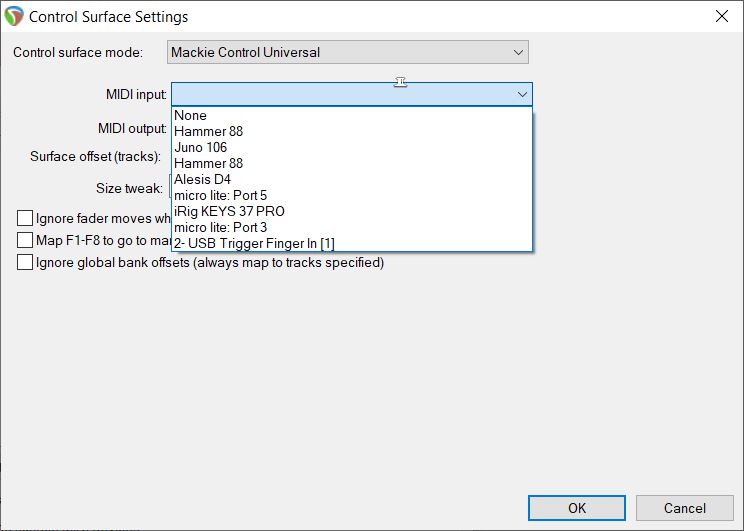
MIDI Output: Notice that the Zoom R16 isn’t on the list of devices to choose from on the drop-down.
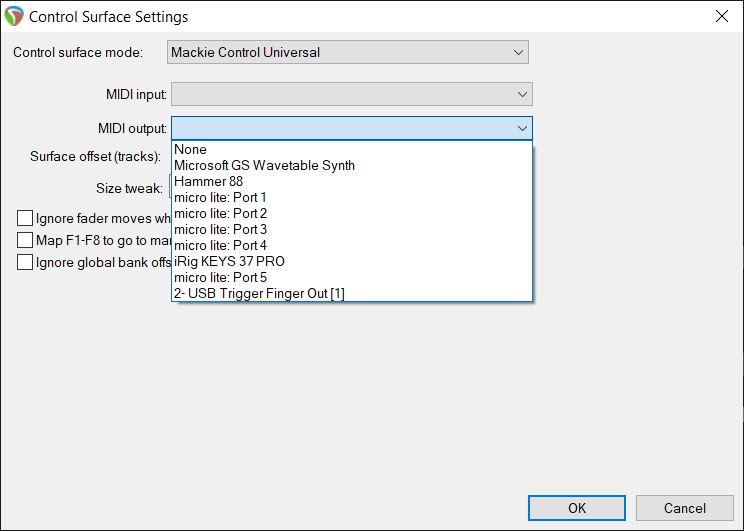
To Resolve Both Issues, Reset the Zoom R16’s USB Mode
With Reaper still open, do the following steps
On the Zoom R16:
- Press the square USB button. (Above LCD screen.)
- It will say AUDIO INTERFACE Terminate?
- Press the round ENTER button.
- USB >AUDIO INTERFACE
- Press the round ENTER button.
- AUDIO INTERFACE / Enter?
- Press the round ENTER button.
- SETTING? [CONTINUE] RESET
- Right Arrow to [RESET]
- Press the round ENTER button.
Check Audio Interface Settings Again
- Open Reaper
- Options / Preferences (Ctrl + P)
- Audio / Device
Audio Device Settings: Notice that the correct settings are back! Your Zoom R16 will now work as an Audio Interface again, meaning that you may use it to record any instruments that are plugged in, and hear audio from powered studio monitor speakers or headphones/earbuds.
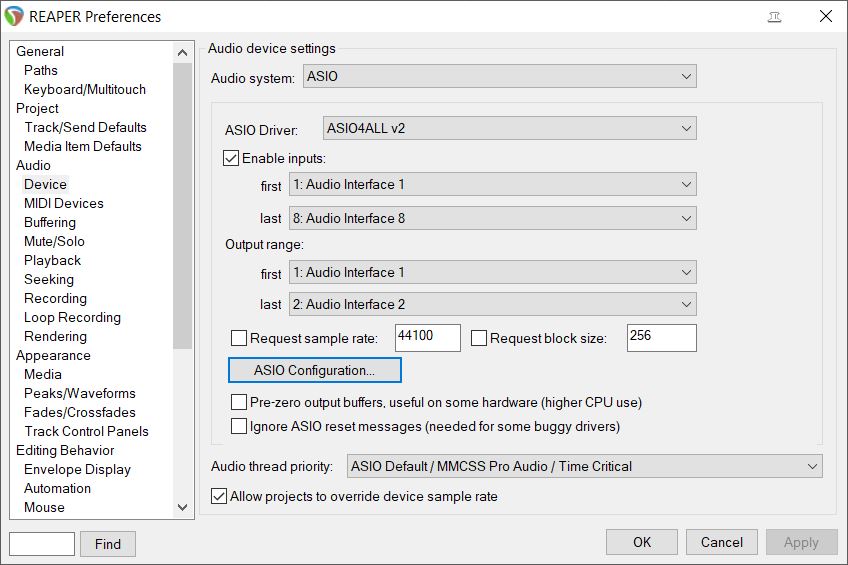
Check Control Surface Setting Again
- Open Reaper
- Options / Preferences (Ctrl + P)
- Control/OSC/web.
- Under Control surfaces/OSC/web control:
- Click Mackie Control (dev 10.16)
- Click Edit.
Control Surface Settings: Notice that the correct settings are back! Your Zoom R16 will now work as a Control Surface again, meaning you may now moving sliders and press transport buttons and they’ll work.
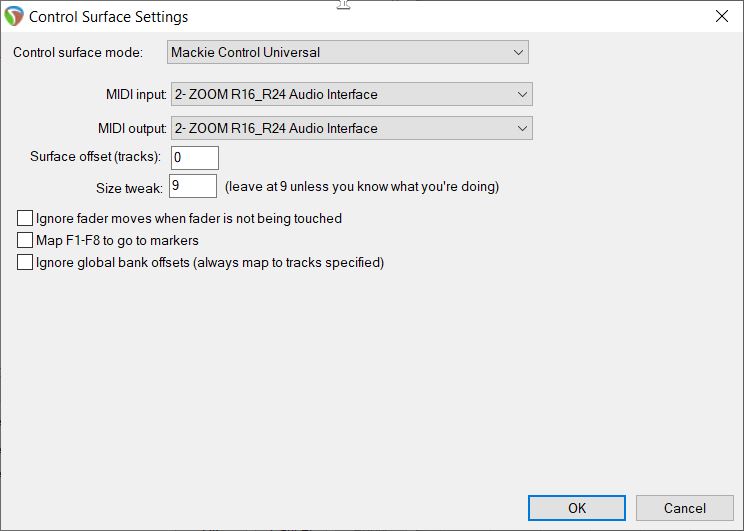
Make sure the Zoom R16 shows up in Device Manager
You could go the extra mile and confirm that the Zoom R16 shows up in Device Manager. If it shows up in Reaper, it will be there.
Reboot Computer
If you have had no luck with these steps troubleshooting your Zoom R16 in Reaper on Windows, try rebooting your computer, and check the settings again.
